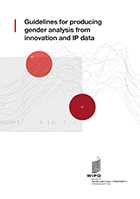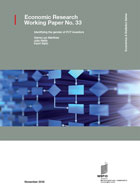Innovation Gender Gap: How to Measure the Gender Gap in Innovation
Monitoring the share of women inventing, creating, and innovating is essential to develop appropriate policy responses to the innovation-related gender participation gap. Yet, several national and international innovation and IP data sources lack any type of gender breakdown.
Fortunately, there are several ways to get innovation and IP data with gender breakdown. Check which one suits your case better.

How to start
There are two main approaches to obtain innovation data with gender breakdown: Getting gender information directly from the source or attributing gender based on other information
1. Getting the gender directly from the source
The most direct way to obtain the gender breakdown for any innovation data is to gather gender information from the source. In the case of inventors (or any IP creator), it means asking them directly about their gender.
How can this be done? Typically, by:
- Surveying the innovators, inventors, or creators about their gender
- Adding a gender field for inventors in the IP application form
The main advantage of sourcing the gender directly from the creators are accuracy and diversity. Self-declaration of gender is more accurate than any attribution technique, and it allows more diverse gender categories.
The main limitations to this approach are cost and past analysis. Surveying the entire inventor and creator population (or samples of these) can be done, but it is a costly task. Adding a gender field in IP applications would require the goodwill of applicants, as it is generally not required by law. Even if necessary in the foreseeable future, it would unlikely be applied retroactively to past IP filings. Understanding the past can provide gender policies for the solutions of the future.
2. Attributing gender to innovation data
Secondary data or information can be used to attribute gender to innovator, inventor, or creator data. How can this be done?
The easiest way is when innovation data contains unique identifiers for individuals (for example, social security numbers or national identity documents - IDs). These IDs can be linked with secondary sources containing detailed records of individuals and including gender information. Typical examples of such sources are national records of individuals or employees. Yet, it is often difficult to obtain access to these records due to privacy concerns. Moreover, the innovation or IP data does not always contain the corresponding individual IDs.
An alternative is to attribute gender based on name titles or language naming customs. For example, patent data may contain inventor names with honorific titles – such as "Mrs.", "Ms.", or " Mr." in English – which can be easily mapped to a given gender. Similarly, the name structure in some languages correlates with gender. For instance, Spanish and Portuguese names ending" "n "o" "a "d "a" can often refer to male and female names, respectively. In Russian "vich" and "vich" or "ovna"and "evna", follow a similar pattern. Yet, there are exceptions to these rules. Titles such as "Prof." or "Dr." are gender-ambiguous, and many languages do not have clear gender patterns in their naming conventions.
A widespread attribution method is to make use of a list of names with their most commonly associated gender. Such lists are often referred to as gender-name dictionaries. One of the main advantages of attributing gender through a gender-name dictionary is that it can be applied to several countries and retroactively.
Of course, as with the other indirect methods, the quality of the gender attribution depends heavily on the quality and coverage of the gender-name dictionary. In addition, migration and changing naming conventions can also affect the coverage of gender-name dictionaries, an issue highlighted already for using language structure or name titles.
Experts explored all of these methods meticulously. In sum, each approach has advantages and disadvantages, which makes them complementary rather than strict alternatives.
The following table summarizes these approaches.
| Method | Advantages | Disadvantages |
| Surveying innovators, inventors, and creators | Direct self-declaration (+++) Gender diversity (+++) |
Not retroactive (---) Implementation time (---) Implementation cost (---) |
| Adding gender field in IP application form | Indirect self-declaration (++) Gender diversity (++) |
Not retroactive (--) Implementation time (--) Implementation cost (--) |
| Attribution based on national individuals records | Very reliable if based on unique identifiers (++) Indirect self-declaration (++) Can be applied retroactively (+) |
Depends on secondary source coverage (--) Privacy rules prevent collecting unique identifiers (--) |
| Attribution based on name titles or language customs | Can be applied retroactively (++) Can be applied to several countries (sharing the same language) (+) |
Spread of naming conventions (--) Not applicable to all languages (--) Affected by migration and naming trends (-) |
| Attribution based on name-gender dictionary | Can be applied retroactively (+++) Can be applied to several countries (++) |
Depends on the dictionary coverage (-) Affected by ambiguous naming conventions (-) |
Do you want to help in measuring the gender gap in innovation and IP?
It is important to consider the above pros and cons when measuring the participation of women in inventing, creating, and innovating activities. One big challenge is to get global coverage of gender participation in innovation activities. Several advanced economies have the resources to come with their solutions to measure gender in their innovation and IP data. Yet, how comparable are these? Moreover, how can we extend the best practices to all the countries in the world?
To assist IP offices and researchers worldwide, WIPO continuously develops a series of resources to measure gender participation. Check the dedicated open repository for these tools and how to use them in your data in your innovation data.
Among other tools, you will find the different versions of the World Gender-Name Dictionary (WGND), compiling the information from more than 40 various sources, covering almost 200 other countries, nearly 100 languages, and more than 25 million name-country-gender combinations.
You can help in the quest by suggesting improvements or directly using them in your research.
Other stories you may enjoy

What do we know about the Gender Gap in Innovation?
Women innovating, inventing, and creating face constant factors that impede their activities. What can economic research tell us about these and inform gender balance policies?

Creating a World Gender Name Dictionary
The World Gender Name Dictionary (WGND) is a tool to assist researchers and policy analysts worldwide in solving the lack of data sources with gender breakdown.
Related resources

Guidelines for producing gender analysis from innovation and IP data
This short guide summarizes best practice for producing innovation and IP gender indicators.

Identifying the gender of PCT inventors
This paper analyzes the gender of inventors in international patent applications.